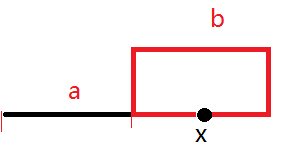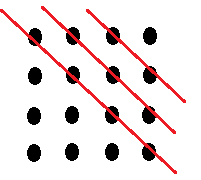转:链表相交有环 经典面试题(三)附答案 算法+数据结构+代码 微软Microsoft、谷歌Google、百度、腾讯
源地址:http://blog.csdn.net/sj13051180/article/details/6754228
1.判断单链表是否有环,要求空间尽量少(2011年MTK)
如何找出环的连接点在哪里?
如何知道环的长度?
很经典的题目。
1.判断是否有环。使用两个指针。一个每次前进1,另一个每次前进2,且都从链表第一个元素开始。显然,如果有环,两个指针必然会相遇。
2.环的长度。记下第一次的相遇点,这个指针再次从相遇点出发,直到第二次相遇。此时,步长为1的指针所走的步数恰好就是环的长度。
3.环的链接点。记下第一次的相遇点,使一个指针指向这个相遇点,另一个指针指向链表第一个元素。然后,两个指针同步前进,且步长都为1。当两个指针相遇时所指的点就是环的连接点。
链接点这个很不明显,下面解释一下。

如图,设链表不在环上的结点有a个,在环上的结点有b个,前两个指针第一次在第x个结点相遇。
S( i )表示经过的总步长为i之后,所访问到的结点。
显然,环的链接点位S( a ),即从起点经过a步之后所到达的结点。
现在要证明:
从第一次的相遇点x再经过a步之后可到达链接点S( a ),即 S( x + a ) = S( a )
由环的周期性可知,只要 a = tb 其中( t = 1, 2, …. ),则S( x + a ) = S( a )
如何证明a = tb?
再看看已知条件,当两个指针第一次相遇时,必有S( x ) = S( 2x )
由环的周期性可知,必有 2x = x + bt, 即x = tb.
- struct Node
- {
- int data;
- Node* next;
- Node( int value ): data(value), next(NULL) {};
- };
- //判断单链表是否有环
- bool IsCircle( Node *pHead )
- {
- //空指针 或 只有一个元素且next为空时,必无环
- if( pHead == NULL || pHead->next == NULL ) return false;
- Node *pSlow = pHead;
- Node *pFast = pHead;
- while( ( pFast != NULL ) && ( pFast->next != NULL ) )
- {
- //分别按步长1、2前进
- pSlow = pSlow->next;
- pFast = pFast->next->next;
- if( pSlow == pFast ) break;
- }
- if( ( pFast == NULL ) || ( pFast->next == NULL ) )
- return false;
- else
- return true;
- }
- //求环的长度
- int GetLen( Node *pHead )
- {
- if( pHead == NULL || pHead->next == NULL ) return false;
- Node *pSlow = pHead;
- Node *pFast = pHead;
- //求相遇点
- while( ( pFast != NULL ) && ( pFast->next != NULL ) )
- {
- pSlow = pSlow->next;
- pFast = pFast->next->next;
- if( pSlow == pFast ) break;
- }
- //计算长度
- int cnt = 0;
- while( ( pFast != NULL ) && ( pFast->next != NULL ) )
- {
- pSlow = pSlow->next;
- pFast = pFast->next->next;
- cnt++;
- //再次相遇时,累计的步数就是环的长度
- if( pSlow == pFast ) break;
- }
- return cnt;
- }
- //求环的入口点
- Node* GetEntrance( Node* pHead )
- {
- if( pHead == NULL || pHead->next == NULL ) return false;
- Node *pSlow = pHead;
- Node *pFast = pHead;
- //求相遇点
- while( ( pFast != NULL ) && ( pFast->next != NULL ) )
- {
- pSlow = pSlow->next;
- pFast = pFast->next->next;
- if( pSlow == pFast ) break;
- }
- pSlow = pHead;
- while( pSlow != pFast )
- {
- //同步前进
- pSlow = pSlow->next;
- pFast = pFast->next;
- }
- return pSlow;
- }
2.用非递归的方式合并两个有序链表(2011年MTK)
用递归的方式合并两个有序链表
基本的链表操作,没什么好说的。
非递归:就是把一个链表上的所有结点插入到另一个链表中。
递归:??
- //两个有序链表的合并
- Node* merge( Node* pHeadA, Node* pHeadB )
- {
- //处理空指针
- if( pHeadA == NULL || pHeadB == NULL )
- {
- return ( pHeadA == NULL ) ? pHeadB : pHeadA;
- }
- //处理第一个节点
- Node *px, *py;
- if( pHeadA->data <= pHeadB->data )
- {
- px = pHeadA; py = pHeadB;
- }
- else
- {
- px = pHeadB; py = pHeadA;
- }
- Node *pResult = px;
- //将py上的节点按顺序插入到px
- Node *pre = px;
- px = px->next;
- while( py != NULL && px != NULL )
- {
- //在px上找到py应该插入的位置
- while( py != NULL && px != NULL && py->data > px->data )
- {
- py = py->next;
- px = px->next;
- pre = pre->next;
- }
- //py插入到pre和px之间
- if( py != NULL && px != NULL )
- {
- //py指针前移
- Node* tmp = py;
- py = py->next;
- //pre指针前移
- Node* tmpPre = pre;
- pre = pre->next;
- //插入
- tmp->next = px;
- tmpPre->next = tmp;
- //px指针前移
- px = px->next;
- }
- else
- break;
- }
- if( px == NULL ) pre->next = py;
- return pResult;
- }
4编程实现:把十进制数(long型)分别以二进制和十六进制形式输出,不能使用printf系列
用位操作实现。十进制数在计算机里本来就是按二进制存储的,因此通过掩码和移位操作很容易输出二进制形式。这里,要注意的一点:对最高位符号位的处理。符号位应该单独处理,否则结果会出错。十六进制的处理和二进制基本相同,只是每次处理四位。
- void LongFormat( long value )
- {
- //处理符号位
- long mask = 0x1 << ( 8 * sizeof(long) - 1 );
- if( value & mask ) cout << "1";
- else cout << "0";
- //转换为二进制
- mask = 0x1 << ( 8 * sizeof(long) - 2 );
- for( int i=1; i<8*sizeof(long); i++ )
- {
- if( value & mask ) cout << "1";
- else cout << "0";
- mask >>= 1;
- }
- cout << endl;
- //处理符号位
- cout << "0x";
- mask = 0xF << ( 8 * sizeof(long) - 4 );
- long tmp = ( value & mask ) >> ( 8 * sizeof(long) - 4 );
- if( tmp < 10 )
- cout << tmp;
- else
- cout << (char)( 'a' + ( tmp - 10 ) );
- //转换为十六进制
- mask = 0xF << ( 8 * sizeof(long) - 8 );
- for( int i=1; i<2*sizeof(long); i++ )
- {
- tmp = ( value & mask ) >> ( 8 * sizeof(long) - 4 * i - 4 );
- if( tmp < 10 )
- cout << tmp;
- else
- cout << (char)( 'a' + ( tmp - 10 ) );
- mask >>= 4;
- }
- }
5.编程实现:找出两个字符串中最大公共子字符串,如"abccade","dgcadde"的最大子串为"cad"
有人说:可用KMP。可惜KMP忘了,找时间补一下。
还有人说:用两个字符串,一个作行、一个作列,形成一个矩阵。相同的位置填1,不同的位置填0。然后找哪个斜线方向上1最多,就可以得到最大公共子字符串。空间复制度0( m*n ),感觉时间上也差不多O( m*n )

没想到什么好办法,只会用最笨的办法O( m*n )。即,对于字符串A中的每个字符,在字符串B中找以它为首的最大子串。哎,即便是这个最笨的方法,也写了好长时间,汗。
- void GetSubStr( char *strA, char *strB, char *ans )
- {
- int max = 0;
- char *pAns = NULL;
- //遍历字符串A
- for( int i=0; *(strA+i) != '\0'; i++ )
- {
- //保存strB的首地址,每次都从strB的第一个元素开始比较
- char *pb = strB;
- while( *pb != '\0' )
- {
- //保存strA的首地址
- char *pa = strA + i;
- int cnt = 0;
- char *pBegin = pb;
- //如果找到一个相等的元素
- if( *pb == *pa )
- {
- while( *pb == *pa && *pb != '\0' )
- {
- pa++;
- pb++;
- cnt++;
- }
- if( cnt > max )
- {
- max = cnt;
- pAns = pBegin;
- }
- if( *pb == '\0' ) break;
- }
- else
- pb++;
- }
- }
- //返回结果
- memcpy( ans, pAns, max );
- *(ans+max) = '\0';
- }
6.有双向循环链表结点定义为:
struct node
{
int data;
struct node *front,*next;
};
有两个双向循环链表A,B,知道其头指针为:pHeadA,pHeadB,请写一函数将两链表中data值相同的结点删除。
没什么NB算法。就是遍历对链表A,对A的每个元素,看它是否在链表B中出现。如果在B中出现,则把所有的出现全部删除,同时也在A中删除这个元素。
思路很简单,实现起来也挺麻烦。毕竟,双向循环链表也算是线性数据结构中最复杂的了。如何判断双向循环链表的最后一个元素?p->next == pHead.
删除操作:
双向循环链表只有一个节点时
双向循环链表至少有两个节点时
- struct Node
- {
- int data;
- struct Node *front,*next;
- Node( int value ): data( value ), front( NULL ), next( NULL ) { };
- void SetPointer( Node *pPre, Node *pNext ) { front = pPre; next = pNext; };
- };
- //如果成功删除返回真。否则,返回假。
- bool DeleteValue( Node *&pHead, int target )
- {
- if( pHead == NULL ) return false;
- //至少有两个元素
- bool flag = false;
- Node* ph = pHead;
- while( ph->next != pHead )
- {
- Node *pPre = ph->front;
- Node *pNext = ph->next;
- if( ph->data == target )
- {
- //如果删除的是第一个元素
- if( ph == pHead ) pHead = ph->next;
- pPre->next = pNext;
- pNext->front = pPre;
- Node *tmp = ph;
- delete tmp;
- //设置删除标记
- flag = true;
- }
- ph = pNext;
- }
- //只有一个元素或最后一个元素
- if( ph->next == pHead )
- {
- if( ph->data == target )
- {
- //如果要删除的是最后一个元素
- if( ph->front != ph )
- {
- Node *pPre = ph->front;
- Node *pNext = ph->next;
- pPre->next = pNext;
- pNext->front = pPre;
- Node *tmp = ph;
- delete tmp;
- }
- else
- {
- delete pHead;
- pHead = NULL;
- }
- flag = true;
- }
- }
- return flag;
- }
- void DeleteSame( Node *&pHeadA, Node *&pHeadB )
- {
- if( pHeadA != NULL && pHeadB != NULL )
- {
- Node *pa = pHeadA;
- while( pa->next != pHeadA )
- {
- //如果B中含有pa->data,并且已经删除
- if( DeleteValue( pHeadB, pa->data ) )
- {
- //在A中删除pa->data
- Node *tmp = pa->next;
- DeleteValue( pHeadA, pa->data );
- pa = tmp;
- }
- else
- pa = pa->next;
- }
- //只有一个元素或最后一个元素
- if( DeleteValue( pHeadB, pa->data ) )
- {
- DeleteValue( pHeadA, pa->data );
- }
- }
- }
7.设计函数int atoi(char *s)。
int i=(j=4,k=8,l=16,m=32); printf(“%d”, i); 输出是多少?
解释局部变量、全局变量和静态变量的含义。
解释堆和栈的区别。
论述含参数的宏与函数的优缺点。
1.字符串转整形,嘿嘿,前面已写过了。
2.逗号表达式的值等于最后一个逗号之后的表达式的值。对应本题,即i=(m=32)
3.局部变量:在函数内定义的变量。作用域范围:只在定义它的块内有效。
全局变量:在函数之外定义的变量。作用域范围:从定义的地方开始直到文件末尾都有效。
静态变量:static变量,属于静态存储方式。静态局部变量在函数内定义,生存期是整个源代码。但是,作用域范围只在定义它的函数内有效。静态全局变量与一般的全局变量:一般全局变量在整个源程序内有效,静态全局变量只在所在文件内有效。
4.堆:一般new出来的变量都在堆里,这里变量要由程序员自己管理,即在不用的时候要及时释放,防止内存泄露。
栈:一般局部变量、函数的参数都在栈里,他们是由编译器来自动管理的。
8.顺时针打印矩阵
题目:输入一个矩阵,按照从外向里以顺时针的顺序依次打印出每一个数字。
例如:如果输入如下矩阵:
1 2 3 4
5 6 7 8
9 10 11 12
13 14 15 16
则依次打印出数字, 2, 3, 4, 8, 12, 16, 15, 14, 13, 9, 5, 6, 7, 11, 10。
分析:包括Autodesk、EMC在内的多家公司在面试或者笔试里采用过这道题
本来想写递归的,结果递归的终止条件比较复杂。因为每次把最外面一圈都出来了,所以矩形的行列都减小2,而且还要记录当前矩形的起始位置。递归终止条件,要考虑行列为0、1的情况。哎,想不清楚。最后还是非递归的好写。也很简单,没啥所的,直接看代码把。
- const int MAX_ROW = 100;
- const int MAX_COL = 100;
- void PrintMatrix( int data[][MAX_COL], int row, int col )
- {
- int top = 0;
- int bottom = row-1;
- int left = 0;
- int right = col-1;
- int cnt = 0;
- int total = row * col;
- while( cnt < total )
- {
- //从左到右,打印最上面一行
- int j;
- for( j=left; j<=right && cnt<total; j++ )
- {
- cout << data[top][j] <<" ";
- cnt++;
- }
- top++;
- //从上到下,打印最右面一列
- for( j=top; j<=bottom && cnt<total; j++ )
- {
- cout << data[j][right] << " ";
- cnt++;
- }
- right--;
- //从右到左,打印最下面一行
- for( j=right; j>=left && cnt<total; j-- )
- {
- cout << data[bottom][j] << " ";
- cnt++;
- }
- bottom--;
- //从下到上,打印最左边一列
- for( j=bottom; j>=top && cnt<total; j-- )
- {
- cout << data[j][left] << " ";
- cnt++;
- }
- left++;
- }
- }
9.对称子字符串的最大长度
题目:输入一个字符串,输出该字符串中对称的子字符串的最大长度。
比如输入字符串“google”,由于该字符串里最长的对称子字符串是“goog”,因此输出。
分析:可能很多人都写过判断一个字符串是不是对称的函数,这个题目可以看成是该函数的加强版
10.用1、2、3、4、5、6这六个数字,写一个main函数,打印出所有不同的排列,如:512234、412345等,要求:"4"不能在第三位,"3"与"5"不能相连.
先不考虑限制条件,我们可以用递归打印出所有的排列(嘿嘿,这个前面写过,可以用递归处理)。然后,只要在递归终止时,把限制条件加上,这样只把满足条件的排列打印出来,就可以了。
- bool IsValid( char *str )
- {
- for( int i=1; *(str+i) != '\0'; i++ )
- {
- if( i == 2 && *(str+i) == '4' ) return false;
- if( *(str+i) == '3' && *(str+i-1) == '5' || *(str+i) == '5' && *(str+i-1) == '3' )
- return false;
- }
- return true;
- }
- void PrintStr( char *str, char *start )
- {
- if( str == NULL ) return;
- if( *start == '\0' )
- {
- if( IsValid( str ) ) cout << str << endl;
- }
- for( char *ptmp = start; *ptmp != '\0'; ptmp++ )
- {
- char tmp = *start;
- *start = *ptmp;
- *ptmp = tmp;
- PrintStr( str, start+1 );
- tmp = *start;
- *start = *ptmp;
- *ptmp = tmp;
- }
- }
11。微软面试题
一个有序数列,序列中的每一个值都能够被2或者3或者5所整除,1是这个序列的第一个元素。求第1500个值是多少?
2、3、5的最小公倍数是30。[ 1, 30]内符合条件的数有22个。如果能看出[ 31, 60]内也有22个符合条件的数,那问题就容易解决了。也就是说,这些数具有周期性,且周期为30.
第1500个数是:1500/22=68 1500%68=4。也就是说:第1500个数相当于经过了68个周期,然后再取下一个周期内的第4个数。一个周期内的前4个数:2,3,4,5。
故,结果为68*30=2040+5=2045
12.从尾到头输出链表
题目:输入一个链表的头结点,从尾到头反过来输出每个结点的值。链表结点定义如下:
struct ListNode
{
int m_nKey;
ListNode* m_pNext;
};
分析:这是一道很有意思的面试题。该题以及它的变体经常出现在各大公司的面试、笔试题中。
链表的反向输出。前面我们讨论过:链表的逆序,使用3个额外指针,遍历一遍链表即可完成。这里当然可以先把链表逆序,然后再输出。链表上使用递归一般也很简单,虽然递归要压栈,但程序看起来很简洁。
- struct ListNode
- {
- int m_nKey;
- ListNode* m_pNext;
- };
- void PrintReverse( ListNode* pHead )
- {
- ListNode* ph = pHead;
- if( ph != NULL )
- {
- PrintReverse( ph->m_pNext );
- cout << ph->m_nKey << " ";
- }
- }



